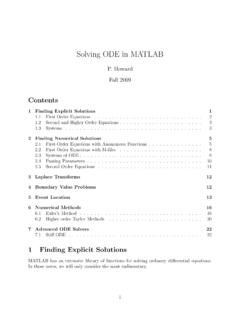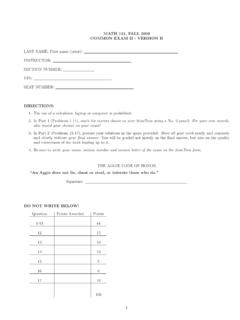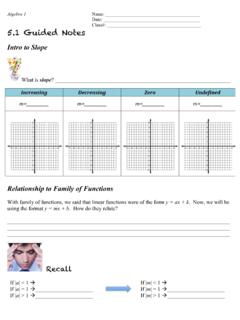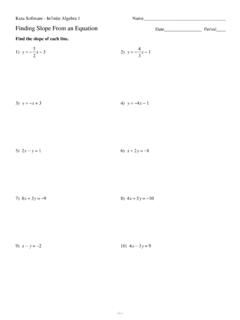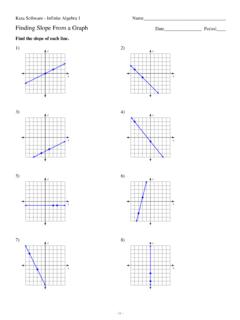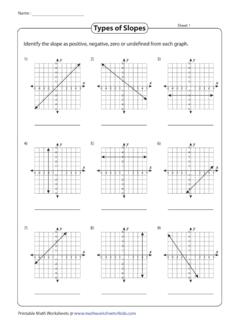Transcription of Slopes, Derivatives, and Tangents - Texas A&M University
1 S Slopes, Derivatives, and Tangents Matt Riley, Kyle Mitchell, Jacob Shaw, Patrick Lane Introduction S The slope of a tangent line at a point on a curve is known as the derivative at that point S Tangent lines and derivatives are some of the main focuses of the study of Calculus S The problem of finding the tangent to a curve has been studied by numerous mathematicians since the time of Archimedes. Archimedes Definition of a tangent line: The tangent line at a point on a curve is a straight line that just touches the curve at that point A Brief History S The first definition of a tangent was "a right line which touches a curve, but which when produced, does not cut it".
2 This old definition prevents inflection points from having any tangent. It has since been dismissed. - Leibniz, a German philosopher and mathematician, defined the tangent line as the line through a pair of infinitely close points on the curve. - - Pierre de Format, Rene Descartes, Christian Huygens, and Isaac Barrow are mathematicians given credit for finding partial solutions. - - Isaac Newton is credited for finding the general solution to the tangent line problem. Pierre de Format Rene Descartes Isaac Newton Gottfried Wilhelm Leibniz Visual Web Tangent Line Equations Derivatives Equation of a Line Moving Variables Vector Calculations Algebra Calculus Implicit Differentiation Parametric/Cartesian Conversions Pre-Calc Trigonometric Equations Functions with Limits Important Concepts: Slopes of Curves S To find the average slope of a curve over a distance h, we can use a secant line connecting two points on the curve.
3 S The average slope of this line between x and (x+h) is the slope of the secant line connecting those two points. Example of secant line m=dydx=f(x+h) f(x)hSlopes of Curves S As the distance between (x) and (x+h) gets smaller, the secant lines can be seen to cut through less of the curve. This is shown in Figure 1 at point M S As the distance becomes INFINITELY smaller, the line only touches one point on the curve. Thus, it is tangent to the curve at that point. This is shown by the red line T in Figure 1, which is tangent to point M Figure 1 Slopes of Curves S This can be represented mathematically by the equation: => mtan= This equation solves for the slope of the tangent line at a specific point, otherwise known as the derivative.
4 The derivative is most often notated as dy/dx or f (x) for a typical function. h 0limf(x+h) f(x)hFinding the Equation of the Tangent Line Once the derivative has been found, it is possible to determine an equation for the tangent line at that point To do this, one must simply use the equation => By plugging in the tangent point and the derivative y ytangent=dydx(x xtangent)Finding the Equation of the Tangent Line For example, if the point (1,3) lies on a curve and the derivative at that point is dy/dx=2, we can plug into the equation to find => y-3=2(x-1) After simplifying, the equation to the tangent line is found to be => y=2x+1 Derivatives of Functions S For any function f(x)
5 , one can create another function f (x) that will find the derivative of f(x) at any point. S Being able to find the derivatives of functions is a critical skill needed for solving real life problems involving tangent lines. S While the limit form of the derivative discussed earlier is important, there are more efficient ways to find derivatives Derivative Rules Derivate of a constant is always zero => dc/dx = 0 Power Rule: S If f(x)=axn where a is a constant S The derivative of f(x)=f (x)=naxn-1 S Simply multiply x by the original exponent, and then subtract 1 from the original exponent. Derivative Rules Product Rule: For two functions f(x) and g(x) multiplied together, the derivative is: = f (x)g(x) + f(x)g (x) Quotient Rule: For two functions f(x) and g(x) divided by one another, the derivative is: ddxf(x)g(x)ddxf(x)g(x)=f'(x)g(x) g'(x)f(x)[g(x)]2 Derivative Rules Chain Rule: ddxf(g(x))=f'(g(x)) g'(x)Trig Rules ddxsinx=cosxddxcosx= sinxddxtanx=sec2xddxcotx= csc2xddxsecx=secxtanxddxcscx= cscxcotxLogarithm/Exponent Rules Logarithm Rule: Exponent Rule: Note: a is a constant ddxlnx=1xddxax=lna axPractice Time: Problem #1 S Ol Rock, the good ag, gigs frogs every week.
6 The number of frogs captured each day t for a week can be approximated by the function S => f(t)= -t2+10t+5, 0 t 6. S Where t=0 is Monday, t=1 is Tuesday, and so on. S When Ol Rock has gigged 26 frogs, at what rate is he gig n frogs? Solution When Ol Rock has gigged 26 frogs, at what rate is he gig n frogs? f(t) = -t2 + 10t + 5, 0 t 6 S 26 = -t2 + 10t + 5 S 0 = -t2 + 10t 21 => factor the equation S 0 = (-t+7)(t-3) S t = 3,7 days S t 7 because 0 t 6 S f (t) = -2t+10 S f (3) = 16 => Ol Rock is gigging at a rate of 16 frogs per day on Thursday (t=3). More Concepts: Derivatives of Parametric Equations S To find the derivative of a parametric equation, one must simply find the ratio of the rate of change of y with respect to the parameter to the rate of change of x with respect to the parameter.
7 => dydx=dydtdxdtMore Concepts: Speed in Parametric Equations When the position of an object is described using two parametric equations, speed can be found by using Pythagorean Theorem. In the figure, the horizontal speed, x (t), corresponds to a. The vertical speed, y (t), corresponds to b. Using Pythagorean Theorem, we can say: Speed = x'(t)2+y'(t)2 Practice Time: Problem #2 S The position of a football (in meters) thrown by Johnny Manziel, with respect to time (seconds), can be modeled in the horizontal direction by => x(t) = 4t and in the vertical direction by => y(t) = -t2+4t where the initial point is considered to be (0,0).
8 S a) Find the equation of the line tangent to the ball s position 4 seconds after it has been released. S b) What is the speed at this time? Solution Part A: Find equation of tangent line at t=4. S y(t) = -t2+4t S y(4) = 0 m S x(t) = 4t S x(4) = 16 m S When t=4: (0,16) S y (t) = -2t+4 S x (t) = 4 S Evaluate the derivative at t=4 S When t=4: S Write the tangent line in point- slope form. Part B: Evaluate speed at t=4 S Speed = S Speed = S Speed = dydx=y'(t)x'(t)dydx= 2t+44dydx= 44x'(t)2+y'(t)2(4)2+( 4)2y 0= 1(x 16)Meters per second 32 Time: Problem #3 S A spring has an amount of energy (in Joules) stored in it that is modeled by S => E(x) = ( )(k)x2 S (where k is the spring constant) when it is stretched or compressed a certain distance, x (m), from its natural position.
9 The mass of the spring is negligible. S What force is needed to compress the spring m if the spring constant is equal to 400 N/m? S (Hint: Force is the derivative of Work) Solution S E(x) = 200x2 S F(x) = Force required for a compression of distance, x. S F(x) = E (x) S F(x) = 400x S F( ) = 600 N => The force required to compress the spring is equal to 600 N. Practice Time: Problem 4 S In order to help the people of New York better prepare for super storm Sandy, fightin Texas Aggie meteorologists in New York measured wind speeds at each hour of time that the storm traveled, starting when the storm was 20 miles from the coast.
10 Problem 4 (cont.) Data Table Problem 4 (cont.) S A) Using this data, find the average rate of change of the wind speed after 5, 10, 15, and 18 hours. S B) What sort of trend do these sample rates of change present? (Hint: Increasing vs Decreasing) Solution Part A: I) x=5 = = = miles per hour squared II) x=10 = = = miles per hour squared III) x=15 = = = miles per hour squared IV) x=18 = = = miles per hour squared y x Approximate the average rate of change of the wind speed by taking the average slope between the two surrounding points. f(6) f(4)6 4f(16) f(14)16 1480 14f(19) f(17)19 1795 17 y x y xf(11) f(9)11 9 y 9 Solution Part B: What sort of trend do these sample rates of change present?


